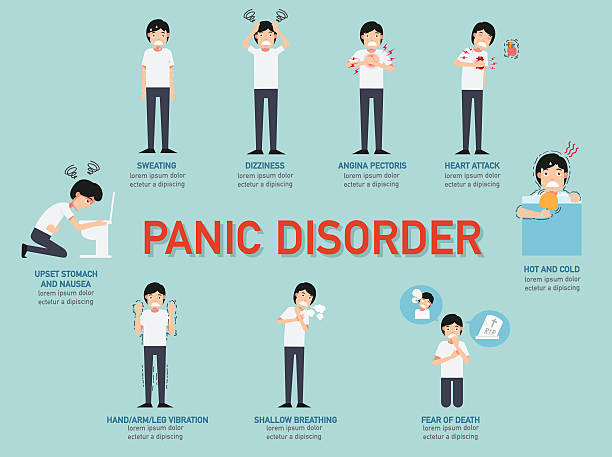Panic disorder is a type of anxiety disorder characterized by recurrent, unexpected panic attacks. Panic attacks are sudden, intense episodes of fear or anxiety that can cause a range of physical symptoms, such as rapid heart rate, sweating, trembling, shortness of breath, and feelings of impending doom. Panic disorder can be a debilitating condition that can significantly impact a person's quality of life.
In this blog, we will explore the causes, symptoms, and treatments of panic disorder.

Causes of Panic Disorder
The exact cause of panic disorder is not well understood, but it is believed to be a combination of genetic, environmental, and psychological factors. Some of the factors that may contribute to the development of panic disorder include:
-
Genetics: Panic disorder may run in families, suggesting a genetic predisposition to the condition.
-
Brain chemistry: Imbalances in certain chemicals in the brain, such as serotonin and norepinephrine, may contribute to the development of panic disorder.
-
Environmental factors: Traumatic events, such as abuse, neglect, or a serious illness, may increase the risk of developing panic disorder.
Symptoms of Panic Disorder

The main symptom of panic disorder is recurrent panic attacks. A panic attack typically lasts for several minutes and can cause a range of physical and emotional symptoms, including:
- Rapid heartbeat or palpitations
- Sweating
- Trembling or shaking
- Shortness of breath or choking sensations
- Chest pain or discomfort
- Nausea or stomach upset
- Dizziness or lightheadedness
- Feeling detached from oneself or reality
- Fear of losing control or going crazy
- Fear of dying
These symptoms can be very frightening and may lead to avoidance of certain situations or places where a panic attack has occurred.
Treatments for Panic Disorder
The good news is that panic disorder is a treatable condition. Treatment typically involves a combination of medication and therapy. Here are some of the most common treatments for panic disorder:
-
Cognitive-behavioral therapy (CBT): CBT is a type of therapy that helps people identify and change negative thought patterns and behaviors that contribute to anxiety and panic attacks.
-
Medications: Antidepressants, such as selective serotonin reuptake inhibitors (SSRIs) and benzodiazepines, can be effective in reducing the frequency and intensity of panic attacks.
-
Relaxation techniques: Techniques such as deep breathing, progressive muscle relaxation, and yoga can help reduce anxiety and promote relaxation.
-
Lifestyle changes: Making healthy lifestyle changes, such as reducing caffeine and alcohol consumption, getting regular exercise, and practicing good sleep habits, can also help reduce anxiety and improve overall mental health.
In summary, panic disorder is a type of anxiety disorder that can be very distressing and debilitating. However, with proper treatment, many people with panic disorder can learn to manage their symptoms and improve their quality of life. If you or someone you know is experiencing symptoms of panic disorder, it's important to seek help from a mental health professional.
Tips to cure panic disorder
-
Practice relaxation techniques: Deep breathing, progressive muscle relaxation, and meditation are techniques that can help reduce stress and anxiety.
-
Exercise regularly: Exercise can help reduce stress and improve mood. Regular exercise is also associated with a reduction in the severity of panic disorder symptoms.
-
Get enough sleep: Lack of sleep can increase feelings of anxiety and stress. Getting enough restful sleep is essential for managing panic disorder symptoms.
-
Avoid stimulants: Stimulants such as caffeine, nicotine, and some medications can increase feelings of anxiety and trigger panic attacks.
-
Practice mindfulness: Mindfulness techniques, such as staying present in the moment and focusing on the present rather than worrying about the future or dwelling on the past, can help reduce anxiety and stress.
-
Join a support group: Talking to others who have experienced panic disorder can help reduce feelings of isolation and provide a sense of community and support.
Keeping oneself busy can be a helpful tool for managing panic disorder symptoms. Here are some suggestions for ways to keep busy and engaged:
-
Engage in a hobby: Find a hobby or activity that you enjoy and that you can do regularly, such as painting, writing, or playing an instrument. This can help reduce stress and provide a sense of purpose.
-
Get outdoors: Spending time in nature can help reduce stress and anxiety. Take a walk, go for a hike, or spend time in a nearby park.
-
Volunteer: Volunteering can provide a sense of purpose and help reduce stress. Consider volunteering at a local shelter, food bank, or community center.
-
Take a class: Learning something new can be both engaging and rewarding. Consider taking a class in a subject you are interested in, such as cooking, photography, or a language.












